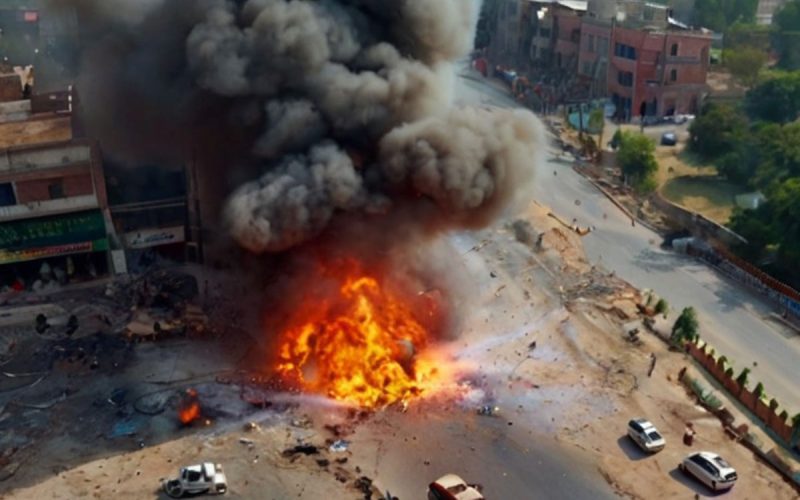Lahore Under Drone Fire
Lahore awoke to chaos as a series of explosions rattled the city, marking the fourth drone attack in a single day. Panic gripped neighborhoods near Walton Airport, Gopal Nagar, and Naseerabad, with sirens blaring and residents fleeing their homes. Clouds of smoke rose above the city, and flight operations at Lahore, Sialkot, and Karachi airports were temporarily suspended. The blasts came just a day after India launched “Operation Sindoor,” targeting terror camps in Pakistan and Pakistan-Occupied Kashmir in retaliation for the Pahalgam terror attack, which killed 26 civilians.
Fear on the Streets
Locals described the night as one of terror. “It was around 12:45 at night. We were asleep when one drone came, followed by three others. They attacked the mosques-everything is destroyed,” a resident recounted. The Walton Road area, leading to Lahore cantonment and adjoining the city’s posh business district, saw people pouring onto the streets in panic. Despite the scale of the attack, initial reports indicated no civilian casualties or major infrastructure damage, but the psychological impact was profound.
DG ISPR Claims Indian Drones Targeted Nine Pakistani Cities
Pakistan’s Director-General of Inter-Services Public Relations (DG ISPR), Lt Gen Ahmed Sharif Chaudhry, claimed that Indian drones have penetrated deep into Pakistani territory, reaching at least nine cities, including major urban centers like Karachi, Lahore, and Gujranwala. According to the DG ISPR, these drone incursions are part of a broader campaign of strikes across multiple regions, with air defense units reportedly engaging the drones in several locations.
The military spokesperson stated that air defense systems were on high alert and had shot down drones near Walton Road in Lahore and in Gujranwala, underscoring the scale and reach of the current hostilities. This assertion marks a significant escalation, as it suggests Indian operations are not limited to border areas but now threaten Pakistan’s heartland and economic hubs, further intensifying public anxiety and the sense of vulnerability across the country.
Operation Sindoor: India’s Calculated Strike
The current escalation traces back to India’s precision air strikes, codenamed Operation Sindoor, which targeted nine locations linked to terror outfits Jaish-e-Mohammed, Lashkar-e-Taiba, and Hizbul Mujahideen. According to Indian sources, over 80 militants were killed. The strikes were a direct response to the April 22 attack in Pahalgam, with Indian forces employing air, naval, and ground assets under the cover of darkness. Four of the nine targets were inside Pakistan, the rest in Pakistan-Occupied Kashmir.
Political Fallout in Pakistan, War of Words, No Admission
Pakistani Prime Minister Shehbaz Sharif condemned the Indian strikes as a “blatant act of war” and vowed a “befitting reply.” He claimed five Indian jets were downed, a statement not confirmed by India. Meanwhile, heavy cross-border shelling erupted along the Line of Control, prompting mass evacuations on both sides. The Pakistani media reported additional drones shot down in Punjab province, but official details remain limited.
Civilian Impacted most, displacement and uncertainty everywhere
Thousands of civilians have been evacuated from border villages as both nations brace for further escalation. The fear of more drone attacks and missile strikes has left communities in a state of uncertainty. Schools and businesses in affected areas have closed, and families are taking refuge in safer zones.
Drone Warfare and Denial
Drone strikes in Pakistan are not new. Historically, U.S. drones targeted militant hideouts in the tribal regions, often with tacit approval from some Pakistani officials, despite public condemnation. The current wave of attacks, however, marks a shift-this time involving direct India-Pakistan confrontation in urban centers like Lahore. The government’s reluctance to address the public reflects a longstanding pattern: private approval or strategic silence, coupled with public denial and condemnation.
The Information War: Conflicting Narratives
Both India and Pakistan are engaged in an information war. While India highlights the precision and necessity of its strikes against terror infrastructure, Pakistan emphasizes civilian casualties and sovereignty violations. Independent verification remains challenging, with both sides restricting media access to key sites.
No End in Sight: Regional Ramifications
The escalation threatens to destabilize the already volatile region. International observers warn that continued drone and missile exchanges could spiral into a broader conflict, with catastrophic consequences for civilians. Calls for restraint from global powers have so far gone unheeded, as both nations dig in for what could become a protracted standoff.
The Human Cost; Stories from the Ground
Behind the headlines are stories of ordinary Pakistanis-families separated, children traumatized by explosions, and communities living in fear. The lack of official communication only deepens the anxiety, leaving citizens to rely on rumors and fragmented reports.
As Lahore reels from its fourth drone attack in a day, the silence from Pakistani authorities is deafening. With no clear explanation or assurance, the city remains on edge, bracing for what may come next. The world watches, hoping for de-escalation, but prepared for the possibility of further violence.





